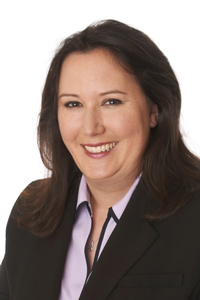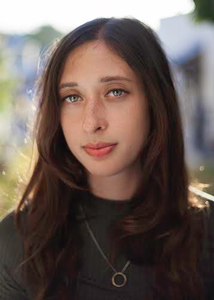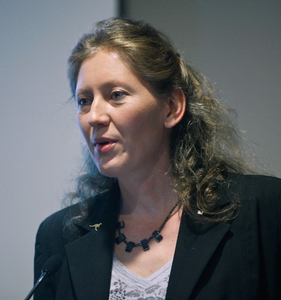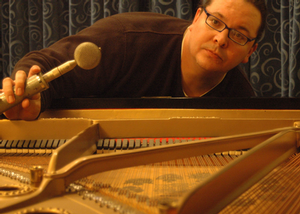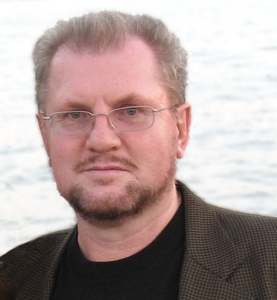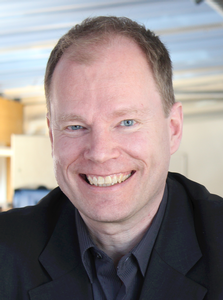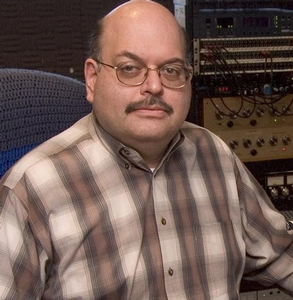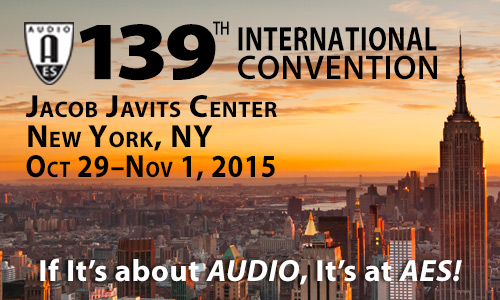
AES New York 2015
Archiving and Restoration Track Event Details
Thursday, October 29, 10:15 am — 11:15 am (Room 1A14)
Archiving: A1 - The Media Digitization and Preservation Project at Indiana University: A Case Study in Large-Scale Preservation of Time-Based Media
Presenters:Andrew Dapuzzo, Memnon
Mark Hood, Indiana University - Bloomington, IN, USA
Konrad Strauss, Indiana University - Bloomington, IN, USA
Abstract:
Indiana University possesses an unusually rich collection of time-based media that document subjects of enduring value. They include wax cylinder sound recordings of Native American music, performances of world renowned musicians, lectures by the leading thinkers of the 20th and 21st centuries, one of the largest collections of ethnographic field recordings, the film collections of Peter Bogdanovich and David Bradley, the collection of the Kinsey Institute for Research in Sex Gender and Reproduction, and many other unique and rare items. In 2010 a task force conducted an inventory of IU collections and identified an excess of 500,000 items that were in need of preservation. As a result, the university provided $15 million in funding to build a facility to digitize and preserve the collections; and make them available to researchers worldwide. This workshop will provide an overview of the survey process, the design of the preservation facility, and an overview of the digitization workflow. We will also discuss the lessons learned from building such a large project and how processes and methodology can be scaled down to work for the small library or archive.
Thursday, October 29, 11:15 am — 12:45 pm (Room 1A14)
Archiving: A2 - Preserving Historic Audio Wax Cylinders and Expert Transfer Techniques
Presenters:Brad McCoy, Library of Congress - Culpeper, VA, USA
Nadja Wallaszkovits, Phonogrammarchiv, Austrian Academy of Science - Vienna, Austria; NOA GmbH
Abstract:
Audio preservation experts have decades of experience with rare and problematic media formats and modes of degradation and have developed sophisticated techniques and work flows to recover the content from a wide variety of damaged, degraded, and obsolete types of storage media. The Library of Congress staff have produced video tutorials on basic playback techniques for wax cylinders conducted by expert practitioners in the field. This presentation will showcase these videos, discuss how they came into being, and plans for disseminating them to the preservation community. Different approaches will be outlined and compared, including internationally proven methods such as improved mechanical signal pickup. Recordings will be played of transfers made of historic cylinders from both the Phonogrammarchiv in Vienna, Austria, and the Library of Congress Packard Campus in Culpepper, VA.
Thursday, October 29, 2:00 pm — 5:00 pm (Off-Site 1)
Technical Tour: TT1 - Brooklyn Phono
Abstract:
Thomas Bernich’s Brooklynphono recycles vinyl and preserves a fading piece of history. In fact, Mr. Bernich’s workplace in Sunset Park is one of the few of its kind in the United States. When it first opened in 2003, Brooklynphono was making about 2,000 records a month. Now, Brooklynphono has five pressing machines, making more than 10,000 records a month.
Part of the tour's cost includes bus transportation to and from this location. You must purchase a ticket at the Tech Tours desk at the Javits. Anyone that shows up without a ticket will be turned away.
Thursday, October 29, 4:45 pm — 5:45 pm (Room 1A14)
Archiving: A3 - Hard to Handle: Unstable Formats
Presenters:Matt Barton, Library of Congress
James Sam, Hoover Institution Archives, Stanford University - Stanford, CA, USA
Seth Winner, Seth B. Winner Sound Studios, Inc. - Merrick, NY, USA
Abstract:
One of the most unstable formats found in audio archives, the lacquer disc requires great expertise to properly handle. Often called an "acetate" in the vernacular, its having multiple parts and potentially a glass base leaves it ripe for various breakages. James Sam will begin will cover the discs’ composition, handling, cleaning, playback, and storage, including the presentation of a housing that was custom-designed by conservators and archivists at Stanford University’s Hoover Institution Library and Archives for the horizontal storage of cracked, broken, and/or delaminating discs. Matthew Barton will be presenting the troubles with playing back 78s. Seth B. Winner will also present the myriad unstable formats he has encountered.
Thursday, October 29, 5:45 pm — 6:45 pm (Room 1A14)
Archiving: A4 - Magnetic Tape and Tomatoes: One Decays Forever, One Is Forever Recoverable
Presenters:Marty Atias, Rezerex Tape Restorations - Silver Spring, MD; ATS Communications
Charles Richardson, Rezerex Magnetic Tape Restorations - Annapolis, MD, USA
Abstract:
What do tomatoes and magnetic tape have in common? They can both react with the atmosphere causing chemical changes to occur. Unlike fruit however, a very common dysfunction of magnetic tape, generally known as Sticky Shed Syndrome, is the result a natural chemical process known as hydrolysis, which interestingly, can offer the option of a naturally occurring inverse reaction known as reverse hydrolysis. Chemical science holds the answers to the complete recovery of existing sticky magnetic tapes and how to manufacture long lasting recording tape free of sticky shed type problems. An explanation by chemical science, lab work, microscopic pictures, and before and after results are provided to attain the goal of high-level restoration and preservation of magnetic tape for a very long time. High levels of mechanical and magnetic performance can only occur by first solving the chemical issues.
Friday, October 30, 9:00 am — 10:15 am (Room 1A14)
Workshop: W6 - Help, I Have a Tape Machine! (Redux)
Chair:Noah Simon, New York University - New York, NY, USA
Panelists:
John French, JRF Magnetic Sciences Inc - Greendell, NJ, USA
Chris Mara, Welcome To 1979 - Nashville, TN, USA
Bob Shuster, Shuster Sound - Smithtown, NY USA
Daniel Zellman, Zeltec Service Labs - New York, NY, USA; Zeltec Research & Development
Abstract:
Although analog tape continues to be a viable format for recording and mixing audio, there is no denying the decline in the manufacture of machines, media and tools for this beloved technology. In order to use analog tape reliably, machines must be maintained and repaired by users armed with technical know-how. This panel will cover topics related to the evaluation, maintenance, repair, and every-day practices to keep this technology functioning to its fullest potential.
Friday, October 30, 12:15 pm — 1:15 pm (Room 1A12)
Tutorial: T13 - CANCELED
Friday, October 30, 4:15 pm — 5:15 pm (Room 1A13)
Archiving: A5 - Bits Is Bits, Right? Check Again!
Presenter:George Blood, George Blood Audio/Video/Film - Philadelphia, PA, USA
Abstract:
In our increasingly digital world the reliability of digital transmission and storage is paramount. From CRCs to public key encryption, systems abound to establish trust in digital information. Preservationists are concerned with bit rot, authenticity and fixity. But what if the bits coming out of the analog-to-digital converter don't make it to the file? How would you know? What can you do about it? This presentation shares information on data loss gathered during a major systems upgrade, the sordid tale of exploring many common hardware and software tools, the sad reality, and a simple test users can perform to search for this problem. Now commonly called interstitial errors, we'll look at loss in both the time and amplitude domains.
Friday, October 30, 5:30 pm — 7:00 pm (Room 1A13)
Workshop: W14 - Intellectual Property Basics for Audio Professionals
Chair:Andrea Yankovsky, Kilpatrick, Townsend & Stockton LLP - New York, NY, USA
Abstract:
Workshop on copyright, trademark, patent, trade secrets, and other IP topics.
Friday, October 30, 6:00 pm — 7:00 pm (Room 1A12)
Archiving: A6 - Anatomy of a Bootleg: Archiving One Part Poetry, One Part Punk
Presenter:Allie Whalen, Independent Archivist / UCLA Library Preservation Program - Los Angeles, CA, USA; NYU MIAP Grad - New York, NY, USA
Abstract:
Just as finding the right speed to play back a record, or finessing the sound from a wax cylinder can be challenging, recordings on magnetic media such as videotape or audio-cassette bring their own unique challenges. These challenges are especially complex when dealing with the homemade and DIY nature of punk collections and are well represented by recordings found in UCLA Library’s S.A. Griffin Collection, currently being digitized by UCLA Library’s AV Preservation Unit. Griffin is an LA-based poet and actor who was closely involved in LA’s neo- beat poetry, punk and performance art scene during the 1980s and 1990s. Content includes recordings of poetry readings and various performances held at iconic, now vanished, LA locations. Performers and groups represent a cross section of the LA poetry, performance, and punk scene including the Lost Tribe and their later incarnation the Carma Bums, Charles Bukowski, Wanda Coleman, and William Burroughs reading Naked Lunch. The non-standard and “rough” nature of the recordings mean dealing with problems like mono/stereo switching mid-recording, inconsistent levels, analog noise (incorrect speed, clicks, pops, dropout, distortion, crackle, buzz) and post-digitization clicks and clipping, all of which require thoughtful assessment. Along these lines, the Griffin project also highlights the importance of thorough documentation and metadata when it comes to preserving such a unique niche collection, as well as the value of being in communication with the donor to provide additional background and context on everything from contributors to recording locations.
Saturday, October 31, 9:00 am — 10:30 am (Room 1A22)
Archiving: A7 - Special Challenge Metadata: Multimedia-Based Preservation of the Collection Oskar Sala or … How to Safeguard Hitchcock’s Birds
Presenter:Nadja Wallaszkovits, Phonogrammarchiv, Austrian Academy of Science - Vienna, Austria; NOA GmbH
Abstract:
Oskar Sala (1910 – 2002) was a German musician, scientist, and a pioneer of electronic music. He played and further developed the trautonium, a predecessor of the synthesizer. By enhancing and modifying this instrument Sala was able to create totally new sounds and effects. He composed the scores for more than 300 films and created the effect soundtrack for Alfred Hitchcock's film The Birds, receiving many awards for his works. After his death he left, among others, a collection of about 1200 analog magnetic audio tapes which are stored in the archives of Deutsches Museum in Munich. Oskar Sala fully exploited all the possibilities of the analog tape technology, using impressive experimental approaches. His tapes have become artworks themselves, as they comprise a unique richness of very special and specific metadata: most of the tapes are cut up to 200 times per reel, and he used them as a (more or less readable) notebook. Such and many more surprises made the adequate safeguarding and digitization of the collection a unique undertaking. This tutorial outlines the various challenges of this project and discusses the parameters and practical problems of the audio transfer, as well as the strategy of safeguarding the richness of metadata by use of multimedia-based documentation, such as photographic capturing and high definition video recording.
Saturday, October 31, 9:00 am — 10:30 am (Room 1A06)
Tutorial: T17 - Counter Clockwise – The Aesthetic Wonder and Technical Merit of Sounds Played Backwards
Presenter:Alex Case, University of Massachusetts Lowell - Lowell, MA, USA
Abstract:
We can learn from pop music’s many examples of artistic expression through the presentation of sounds While such sounds can’t happen in nature, they are a common studio creation. Alex U. Case demonstrates and discusses their strong musical value, and intriguing technical and perceptual advantages.
Saturday, October 31, 10:00 am — 11:00 am (Room 1A19)
TC Meeting: Archiving, Restoration and Digital Libraries
Saturday, October 31, 10:30 am — 1:00 pm (Off-Site 1)
Technical Tour: TT7 - Rogers and Hammerstein Archives
Abstract:
The Rodgers and Hammerstein Archives of Recorded Sound of The New York Public Library is one of the richest resources of recorded sound in the world. The Archives contains approximately 700,000 recordings and more than 100,000 printed items. A vital research facility for performers, musicians, scholars, critics, and the recording industry, the collection also plays a leadership role in developing technology that allows for the transfer of sound from obsolete to accessible formats.
Virtually every format developed to record sound—wax cylinders, acetate and aluminum discs, magnetic wire recordings, 78rpm recordings, audiocassettes, compact discs, digital audiotape—can be found in the Archives. In the Archives sound studios, staff engineers have pioneered methods of sound preservation and transfer, helping to set standards for the field.
This AES tour will have the opportunity to handle rare and obsolete formats, a tour of the archival holdings, and an brief overview of the audio preservation program at New York Public Library.
Location: Rodger & Hammerstein NYPL
Dorothy & Lewis B Cullman Center
40 Lincoln Center Pl, 3rd flr, New York, NY
Bus transportation is not provided. We'd suggest taking the 7 Train to the 1 Train to 66th St.
Limited to 30 people. A ticket is required - anyone showing up without a ticket will be turned away.
Saturday, October 31, 1:30 pm — 3:00 pm (Room 1A14)
Tutorial: T18 - Horns and Waveguides—History, Theory, and Technology
Presenter:Alexander Voishvillo, JBL/Harman Professional - Northridge, CA, USA
Abstract:
Horns are undoubtedly the oldest audio equipment. There are two major functions of horns: providing high-efficiency of horn-loaded transducers (often in combination with phasing plugs in compression drivers,) and providing desirable SPL coverage and directivity control. The tutorial will consider such aspects of horns as derivation of basic horn wave equation (Webster Equation), analysis of directivity control, the role of the wavefront at the throat of horn on directivity of horns at high frequencies, influence of the high-order modes on performance of horns, influence of the mouth diffraction on performance, comparison of axisymmetric, elliptical, and rectangular horns. Also nonlinear propagation effects due are analyzed and explained. Retrospective review of patents is carried out as well as the review of the technical achievements of JBL Professional in horns and waveguides technologies.
Saturday, October 31, 1:45 pm — 3:45 pm (Room 1A12)
Archiving: A8 - The 78 Project: Special Screening and Q&A with Creators followed by Live Record Cutting
Presenters:Alex Steyermark, Filmmaker
Lavinia Jones Wright, Filmmaker
Abstract:
The 78 Project is on a journey across America to make one-of a-kind 78rpm records with musicians in their hometowns using a 1930s Presto direct-to-disc recorder. With one microphone. With one blank disc. In one 3-minute take. Along the way, a kaleidoscope of technologists, historians, and craftsmen from every facet of field recording – Grammy-winning producers, 78 collectors, curators from the Library of Congress and Smithsonian – provide insights and history. In Tennessee, Mississippi, California, Louisiana the folk singers, punk rockers, Gospel and Cajun singers in the film share their lives through intimate performances, and find in that adventure a new connection to our cultural legacy.
Saturday, October 31, 4:00 pm — 8:00 pm (Off-Site 4)
Technical Tour: TT9 - Thomas Edison Museum
Abstract:
Thomas Edison National Historical Park preserves Thomas Edison's laboratory in West Orange, New Jersey. For more than 40 years, the laboratory had a major impact on the lives of people worldwide. Out of the West Orange laboratories came the motion picture camera, improved phonographs, sound recordings, silent and sound movies, and the nickel-iron alkaline electric storage battery. This visit will include both a tour of the facility and a recording demonstration.
Part of the tour's cost includes bus transportation to and from this location. You must purchase a ticket at the Tech Tours desk at the Javits. Anyone that shows up without a ticket will be turned away.
Limited to 50 people.
Saturday, October 31, 5:30 pm — 7:00 pm (Room 1A07)
Tutorial: T19 - Listening Tests—Understanding the Basic Concepts
Presenter:Jan Berg, Luleå University of Technology - Piteå, Sweden
Abstract:
Listening tests and other forms of data collection methods that rely on human responses are important tools for audio professionals, as these methods assist our understanding of audio quality. There are numerous examples of tests, either formally recommended and widely used, or specially devised for a single occasion. In order to understand listening tests and related methods, and also to potentially design and fully benefit from their results, some basic knowledge is required. This tutorial aims to address audio professionals without prior knowledge of listening test design and evaluation. The fundamentals of what to ask for, how to do it, whom to engage as listeners, what sort of results that may be expected and similar issues will be covered. The goal is to create an understanding of the basic concepts used in experimental design in order to enable audio professionals to appreciate the possibilities of listening tests.
Sunday, November 1, 9:00 am — 10:00 am (Room 1A14)
Archiving: A9 - Seth B. Winner Sound Studios: The First 25 Years
Presenter:Seth Winner, Seth B. Winner Sound Studios, Inc. - Merrick, NY, USA
Abstract:
Seth Winner has been the president and its only employee of SBWSS since April of 1990. His talk will focus on the various projects he has worked on in the commercial industry as well as in the archival community for last two and a half decades. Among the companies he was hired by were SONY, BMG, The New York Philharmonic, The Metropolitan Opera & Guild, The Minnesota Orchestra, Pavilion Records, The Vitaphone Project/Warner Brothers, and many smaller independent labels. As a result, he has garnered one Honorable Mention and three nominations from NARAS/Grammy Foundation. Institutional work includes preservation and studio setups for UMKC/Marr Sound Archives, The Thomas Edison National Historical Park and Harvard University. Mr. Winner was one of two engineers that preserved the vast holdings of the Benny Goodman & Benny Carter Collections housed at the Institute of Jazz Studies, Rutgers University; this project contained over 700 reels of unpublished performances. One of his recent endeavors was the unearthing of the original set of lacquers made during the historic 1938 Benny Goodman Carnegie Hall Concert; he will discuss, among other things, its discovery, digital preservation and restoration. Oh yes, he has been a member in good standing with AES since 1989, and had given talks at its 1990, 1991, and 1999 conventions.
Sunday, November 1, 10:15 am — 11:15 am (Room 1A22)
Archiving: A10 - Simple. Secure. Safe: Partnering Initiatives with The Internet Archive
Presenter:B. George
Abstract:
The Music Locker has been created to save millions of dollars, free up millions of man hours and avoid years of wasted energy. The simple idea is to pool the known digitized copies of every sound recording available, then allow institutions who own a physical copy, access to the digital version. All texts that are a part of any packaging will also be available digitally, OCR searchable. In this way any institution having a copy of a recording can avoid the work of creating a listening copy necessary for in-house use or study. You control access. You can save locally. Simple, secure, safe.
Sunday, November 1, 1:00 pm — 2:30 pm (Room 1A10)
Archiving: A11 - Audio Preservation Through Imaging: IRENE & The Talking Doll Transfers
Presenters:Peter Alyea, Library of Congress
Jerry Fabris, Thomas Edison National Historical Park
Carl Haber, Lawrence Berkeley Labs
Mason Vander Lugt, Library of Congress
Abstract:
Sound recordings that were lost to history are now accessible again. This panel will take a look at the development of non-invasive technology, its use, and applications for special collections. This panel will begin with IRENE’s creator, Carl Haber, who will provide an overview of minimally invasive and automated approaches to recorded sound preservation and access. Peter Alyea leads the IRENE project at Library of Congress in its Preservation Reformatting Division. Mason Vander Lugt is a preservationist who has worked extensively with IRENE. Then Jerry Fabris will present how IRENE was used to capture the audio of the Edison Talking Doll cylinders, the world’s earliest commercial recordings.
